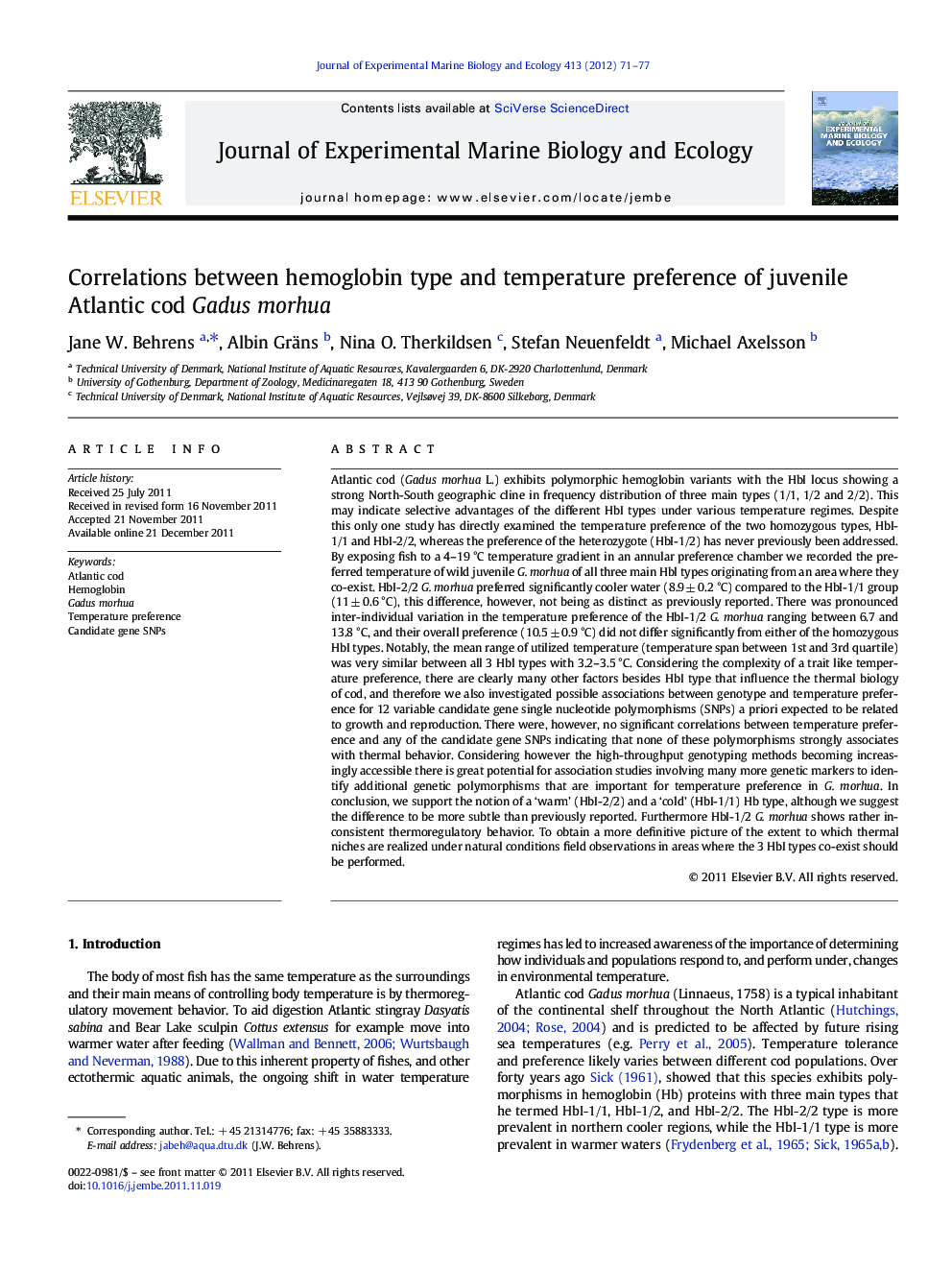| کد مقاله | کد نشریه | سال انتشار | مقاله انگلیسی | نسخه تمام متن |
|---|---|---|---|---|
| 4396128 | 1618451 | 2012 | 7 صفحه PDF | دانلود رایگان |

Atlantic cod (Gadus morhua L.) exhibits polymorphic hemoglobin variants with the HbI locus showing a strong North-South geographic cline in frequency distribution of three main types (1/1, 1/2 and 2/2). This may indicate selective advantages of the different HbI types under various temperature regimes. Despite this only one study has directly examined the temperature preference of the two homozygous types, HbI-1/1 and HbI-2/2, whereas the preference of the heterozygote (HbI-1/2) has never previously been addressed. By exposing fish to a 4–19 °C temperature gradient in an annular preference chamber we recorded the preferred temperature of wild juvenile G. morhua of all three main Hbl types originating from an area where they co-exist. HbI-2/2 G. morhua preferred significantly cooler water (8.9 ± 0.2 °C) compared to the HbI-1/1 group (11 ± 0.6 °C), this difference, however, not being as distinct as previously reported. There was pronounced inter-individual variation in the temperature preference of the HbI-1/2 G. morhua ranging between 6.7 and 13.8 °C, and their overall preference (10.5 ± 0.9 °C) did not differ significantly from either of the homozygous HbI types. Notably, the mean range of utilized temperature (temperature span between 1st and 3rd quartile) was very similar between all 3 Hbl types with 3.2–3.5 °C. Considering the complexity of a trait like temperature preference, there are clearly many other factors besides HbI type that influence the thermal biology of cod, and therefore we also investigated possible associations between genotype and temperature preference for 12 variable candidate gene single nucleotide polymorphisms (SNPs) a priori expected to be related to growth and reproduction. There were, however, no significant correlations between temperature preference and any of the candidate gene SNPs indicating that none of these polymorphisms strongly associates with thermal behavior. Considering however the high-throughput genotyping methods becoming increasingly accessible there is great potential for association studies involving many more genetic markers to identify additional genetic polymorphisms that are important for temperature preference in G. morhua. In conclusion, we support the notion of a ‘warm’ (HbI-2/2) and a ‘cold’ (HbI-1/1) Hb type, although we suggest the difference to be more subtle than previously reported. Furthermore HbI-1/2 G. morhua shows rather inconsistent thermoregulatory behavior. To obtain a more definitive picture of the extent to which thermal niches are realized under natural conditions field observations in areas where the 3 HbI types co-exist should be performed.
► Atlantic cod exhibits three main HbI types which show differential geographical distribution.
► We examine if cod of the 3 Hbl types differ in preferred temperature.
► Further, we look for correlations between variation in candidate gene SNPs and preferred temperature.
► HbI-2/2 cod prefer cooler water than HbI-1/1 animals whereas HbI-1/2 exhibits variable preferences.
► None of the candidate gene SNPs correlated with temperature preference.
Journal: Journal of Experimental Marine Biology and Ecology - Volume 413, 10 February 2012, Pages 71–77